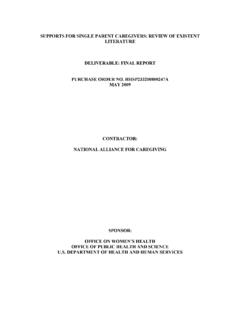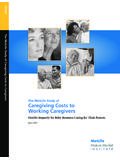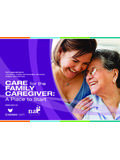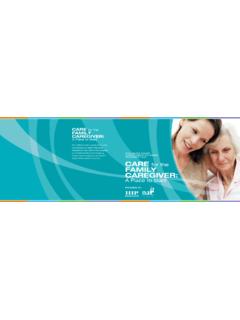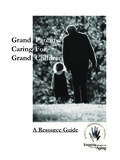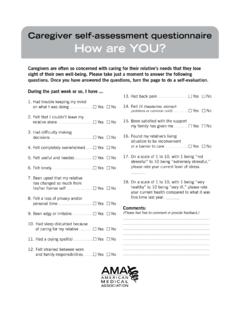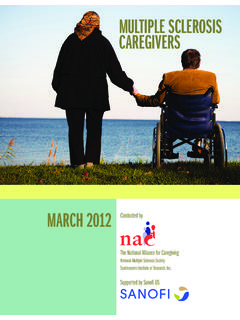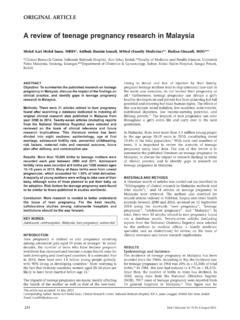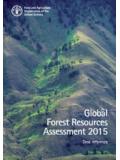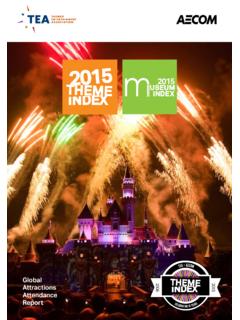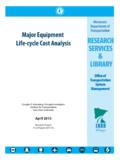Transcription of Executive Summary: Caregiving in the U.S. - AARP
1 RESEARCH REPORTJUNE 2015 Caregiv ing in the Summar yConducted byRESEARCH REPORTC aregiving in the 2015 Executive Summary Acknowledgments The National Alliance for Caregiving ( NAC) and the AARP Public Policy Institute are proud to present Caregiving in the 2015 . Many people played important roles throughout the research process, including: Gail Gibson Hunt, National Alliance for Caregiving Rick Greene, MSW, National Alliance for Caregiving C. Grace Whiting, JD, National Alliance for Caregiving Susan Reinhard, PhD, AARP Public Policy Institute Lynn Friss Feinberg, MSW, AARP Public Policy Institute Rita Choula, AARP Public Policy Institute Jordan Green, MS, AARP Public Policy Institute Ari Houser, PhD, AARP Public Policy Institute NAC Advisory Panel Donna Benton, PhD, Family Caregiver Support Program, University of Southern California Thomas Dudley, MS, RN, Centers for Medicare & Medicaid Services Marty Ford, JD, the Arc Cindy Hounsell, JD, WISER Jed Johnson, Easter Seals Carol Levine, PhD, United Hospital Fund of New York City Katie Maslow, MSW, Institute of Medicine Ruth Stein, MD, Albert Einstein College of Medicine Catherine Thurston, LCSW, Services and Advocacy for GLBT Elders Nancy Vuckovic, PhD, Intel Donna Wagner, PhD.
2 New Mexico State University Jennifer Wolff, PhD, Johns Hopkins University This research was made possible through generous sponsorship from: AARP Archstone Foundation Eli Lilly Home Instead Senior Care MetLife Foundation Family Support Research and Training Center (FSRTC), University of Illinois-Chicago1 Pfizer U nitedHealthcare The research was conducted for NAC and the AARP Public Policy Institute by Greenwald & Associates, with study direction by Lisa Weber-Raley and Erin Smith. (c) 2015 NAC and AARP Public Policy Institute Reprinting with permission 1 With respect to funding received from FSRTC, this work was performed under a subcontract with the University of Illinois at Chicago and made possible by grant number H113B140046 from the Department of Education/NIDRR. Its contents are solely the responsibility of the authors and do not necessarily represent the official views of the Department of Education/NIDRR.
3 1 Caregiving in the 2015 Executive Summary Table of .. 4 of Methodology .. 6 Findings .. 9 Prevalence of 9 Basics of the Caregiving Situation .. 9 Care Recipient Condition .. 12 Caregiving Activities and Burden of Care .. 13 Medical/Nursing Tasks .. 16 Presence of Other Help .. 18 Choice .. 19 Stress and Strain of Caregiving .. 20 Impact of Caregiving on Work .. 22 Information Needs and Caregiving Support .. 24 Long-Range Planning .. 27 and Conclusions .. 29 Profile .. 30 2 Caregiving in the 2015 Executive Summary Table of Figures Figure 1: Estimates of Individual Caregiving Prevalence by Age of Recipient .. 9 Figure 2: Spotlight on Caregivers Ages 75 or Older .. 10 Figure 3: Duration of Care for Recipient .. 11 Figure 4: Where Care Recipient Lives.
4 11 Figure 5: Types of Care Recipient Conditions .. 12 Figure 6: Spotlight on Higher-Hour Caregivers .. 13 Figure 7: Help with Activities of Daily Living (ADLs) .. 14 Figure 8: Difficulties with Activities of Daily Living .. 14 Figure 9: Help with Instrumental Activities of Daily Living (IADLs) .. 15 Figure 10: Help with Other Key Activities .. 16 Figure 11: Level of Care Index .. 16 Figure 12: Help with Medical/Nursing Tasks .. 17 Figure 13: Medical/Nursing Task Difficulty .. 17 Figure 14: Medical/Nursing Task Preparation .. 18 Figure 15: Presence of Other Unpaid Caregivers .. 18 Figure 16: Choice in Taking on Caregiver Role .. 19 Figure 17: Spotlight on Caregivers Having No Choice .. 19 Figure 18: Impact of Caregiving on Caregiver's Health .. 20 Figure 19: Emotional Stress of Caregiving .. 21 Figure 20: Financial Strain of Caregiving .
5 21 Figure 21: Work Impacts Due to Caregiving .. 22 Figure 22: Selected Work Impacts by Hours Worked per Week .. 23 Figure 23: Hours Worked and Work Impacts by Self-Employment .. 23 Figure 24: Workplace Benefits by Hours Worked per Week .. 24 Figure 25: Need Gap in Conversations with Providers .. 25 Figure 26: Affordable Assistance in Care Recipient s Area .. 26 Figure 27: Helpfulness of Caregiving Support Policies .. 27 Figure 28: Expectations of Future Caregiving Roles .. 27 Figure 29: Demographic Summary by Hours Spent Caregiving per Week .. 30 3 Caregiving in the 2015 Executive Summary I. IntroductionThe purpose of this study is to present a portrait of unpaid family caregivers today. To that end, the National Alliance for Caregiving (NAC) and the AARP Public Policy Institute are proud to present Caregiving in the 2015 , based on data collected in late 2014.
6 A national profile of family caregivers first emerged from the 1997 Caregiving in the study. Related studies were conducted in 2004 and 2009 by the NAC in collaboration with AARP. This study builds on those prior efforts, but was conducted against the backdrop of a societal shift in technology,2 requiring a shift to online data collection. Caregiving in the 2015 should be considered a stand-alone research effort, and should not be compared with prior waves conducted via landline telephone only (1997, 2004, or 2009). Caregiving in the 2015 establishes a new baseline for examining changes to Caregiving in the future. The core areas that we examined in this study include the following: - The prevalence of caregivers in the United States - Demographic characteristics of caregivers and care recipients - The caregiver s situation in terms of the nature of Caregiving activities, the intensity and duration of care, the health conditions and living situation of the person to whom care is provided, and other unpaid and paid help provided - How Caregiving affects caregiver stress, strain, and health - Information needs related to Caregiving - Public policy and caregiver support The unique areas of exploration were the following.
7 - Medical/nursing tasks - Hospitalization of care recipients - Supports provided to and impacts on working caregivers - Older caregivers age s 65- plus 2 Discussed in depth later and in the accompanying appendix B, Detailed Methodology, nearly 60 percent of Americans have no landline telephone or use their cell phone primarily. Blumberg, S. & Luke, J. Wireless Substitution: Early Release of Estimates From the National Health Interview Survey, January June 2014. Department of Health and Human Services, Centers for Disease Control and Prevention, National Center for Health Statistics, National Health Interview Survey, Early Release Program. December 2014. 4 Caregiving in the 2015 Executive Summary Caregivers are as diverse as the United States as a whole: they come from every age, gender, socioeconomic, and racial/ethnic group.
8 They share positive aspects of Caregiving . They also share many struggles, but can face different challenges depending on their circumstances. Caregivers may need differing support depending on their loved one s condition and needs, and their own problems, strengths, and resources. This summary highlights Caregiving in the 2015 study findings, while drawing special attention to some vulnerable groups of caregivers who face complex, high burden care situations, sometimes resulting in higher stress and strain for the m. These vulnerable groups include older caregivers, caregivers who had no choice in taking on their Caregiving role, and higher-hour caregivers (those providing greater hours of care weekly). In addition to this Executive summary report, other publications resulting from this study are the following: - A full report of findings, including appendices with the questionnaires and detailed methodology.
9 - T wo companion reports (forthcoming), that separately explore the experiences of caregivers whose loved one is 1) age 18 to 49, and 2) age 50 or older. 5 Caregiving in the 2015 Executive Summary II. Overview of MethodologyThis report is based primarily on quantitative online interviews with 1,248 caregivers age s 18 and older who provide care to an adult. Caregivers of adults are defined as those who provide unpaid care, as described in the following question: At any time in the last 12 months, has anyone in your household provided unpaid care to a relative or friend 18 years or older to help them take care of themselves? This may include helping with personal needs or household chores. It might be managing a person's finances, arranging for outside services, or visiting regularly to see how they are doing. This adult need not live with you.
10 Additionally, to estimate the national prevalence of Caregiving for someone of any age, the study asked respondents if they had provided care to a child with special needs in the past year, as described in the following question:3 In the last 12 months, has anyone in your household provided unpaid care to any child under the age of 18 because of a medical, behavioral, or other condition or disability? This kind of unpaid care is more than the normal care required for a child of that age. This could include care for an ongoing medical condition, a serious short-term condition, emotional or behavioral problems, or developmental problems. Only caregivers of adults were eligible to complete the full online interview. Results from the screening question about caring for a child with special needs were included in the prevalence estimates only.


